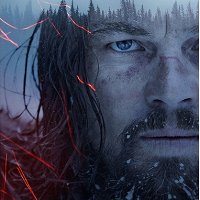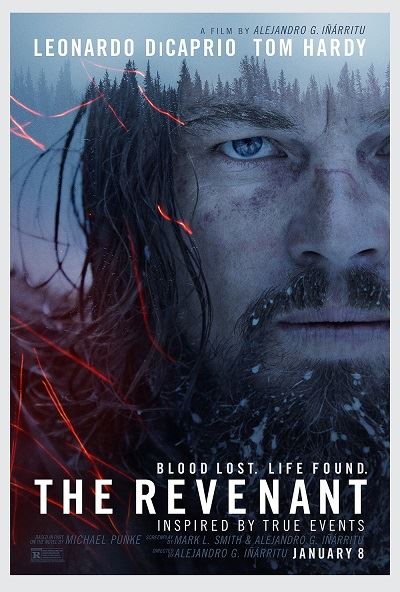 In THE REVENANT, the highly anticipated film from 20th Century Fox, Leonardo DiCaprio plays Hugh Glass, a fur trapper and frontiersman who is left for dead deep in the unchartered American wilderness by a traitorous member of his team, John Fitzgerald (Tom Hardy). Inspired by a true story, the film is directed and cowritten by renowned filmmaker and Academy Award-winner Alejandro González Iñárritu (Birdman, Babel).
In THE REVENANT, the highly anticipated film from 20th Century Fox, Leonardo DiCaprio plays Hugh Glass, a fur trapper and frontiersman who is left for dead deep in the unchartered American wilderness by a traitorous member of his team, John Fitzgerald (Tom Hardy). Inspired by a true story, the film is directed and cowritten by renowned filmmaker and Academy Award-winner Alejandro González Iñárritu (Birdman, Babel). 
“BEFORE AMERICA WAS AMERICA” CAST AND CREW DISCUSS THE AMBITIONS AND CHALLENGES OF MAKING THE REVENANT
 I. RECREATING AN UNKNOWN PAST
I. RECREATING AN UNKNOWN PAST
How do you recreate a past that’s barely been documented? That was just one of the challenges that faced the cast and crew of The Revenant. As star Leonardo DiCaprio observes: “Making the film was almost like making a science fiction movie because there was so little to work with. I mean, not only would cinema audiences not know much about this time period, but I don’t think historians know that much about this time period either. Simply because America wasn’t America. It was the Amazon at that time. It was inhabited by indigenous people and the fur trade was sort of the first infiltration of the white man into nature, and how he manipulated that for capitalistic purposes. The fur trade was before the gold rush. It was before the oil rush. It was before we sent explorers to understand what this landscape was like.”
This sense of journeying into the unknown, or at least the unfamiliar, was just one of the attractions for director Alejandro González Iñárritu: “It is a very interesting moment in the history of this country,” he offers. “These were people in unchartered territory having real adventures. Not like us with our GPS and ‘Oh, let’s have an adventure in India.’ We don’t have adventures anymore. We know where things are. But I feel the early 19th Century has never been explored in depth because it was an unknown. There are literally no stories that have captured that period with accuracy. There was no photography; there was nothing. So everything from that period is still kind of more legend than fact. Even the Hugh Glass story. We know he survived a grizzly bear attack and sought revenge on those who abandoned him, but before and after that, his life is unknown.”
“A lot of research was done through the journals that the fur trappers kept,” confirms DiCaprio. “Because there were no novels at that time about this. There were no writers going there. It was just men hunting. There are no photographs, only etchings and drawings and stories from American Indians about what it was like.”
Production Designer Jack Fisk echoes DiCaprio: “I read the journals of people who were there, clerks, trappers; I read everything I could. But in terms of visuals, I looked at the work of the Swiss painter Karl Bodmer, which is exquisite. Because even with all the journals, paintings and sketches you can find, you still have to interpret the material. Even at the time, people were interpreting things in their own way – you have to read between the lines a bit. I tried to read around and behind the subject. You find details – the soldiers had open latrines, there would be lice and rats… it wasn’t pleasant. In fact, a lot of the trappers would choose to live with the Native Americans because they were cleaner, they bathed every day, and their habitats were just better maintained.”
To accurately portray the grim lives of the trappers, many of the cast were sent to ‘Boot Camp’ to learn some of the skills of the era.
“I actually found that rather enjoyable,” says Will Poulter, who plays trapper Jim Bridger. “We did kind of everything from skinning beavers to riding horses to trying to build your own fire. A lot of what we did was really fun and very informative, not to mention quite integral in bringing us together as a group. The boot camp was very useful in terms of forging a genuine bond between us all. We were all staying in the same hotel and eating with each other every night, and all of that really helped to create a genuine sense of camaraderie. I think it was essential to what we ended up having to do on screen.”
“The camp definitely helped,” agrees Domnhall Gleeson, who plays Captain Andrew Henry. “Every little skill you learned, even if you didn’t use it in the film, brought you a little closer to your character.”
“I learned everything about survival there,” says DiCaprio. “And there was a lot of detail embedded in the script too. We had specialists to learn about the muskets we were using, which take a minute to reload. And the bear fur I had to wear… an animal which nearly kills me all of a sudden becomes my means of surviving the elements. How to start fires, how to eat, how to survive the cold temperatures. We needed to learn all of that stuff. The journals of the fur trappers gave us a sense of the conditions that these men had to go through, and they were clearly incredibly tough. It’s a different era of man, so to speak. I mean, I love nature. I do environmental work and stuff in the wild all the time. But by no means would I ever be able to say I’m a Bear Grylls-type! I couldn’t do what these men did.”
As well as portraying the trappers as authentically as possible, the filmmakers naturally wanted to do the same with the Native Americans.
“The most important thing,” explains Iñárritu, “was that they did not become just the classic ‘Oh, the Native Americans’, ‘the Indians, or ‘the bad guys,’ or ‘the dangerous guys,’ or ‘the mysterious guys.’ My intention was always to give them very strong and very human reasons like any other person, not patronize them, and not make them the victims. I didn’t want to make them just pure and good either. I simply tried to humanize them. They are not good. They are not bad. They are just looking for exactly the same things as anyone: respect, dignity, to be heard.”
II. LOCATING THE AUTHENTIC
Authenticity was crucial to The Revenant. That meant not only researching the lives of the characters, but also finding locations that would help make the film a totally immersive experience, even if those locations were remote.
“I actually started scouting locations about five years ago,” says Iñárritu. “I knew that the film would require almost 100 locations, and it’s not like shooting in a city where you can say, ‘Okay we need a bar, we need a building, we need an apartment, we need a taxi,’ you know? Often times, the logistics are easy to solve, but when you have a landscape and a film that is in an autumn and winter, and where it goes from deep woods with huge trees to the plains, and ends up in the Rockies, and then in the middle of a valley… the distance to get to those locations, the logistics that imply even going from one little hill to a creek with snow, sometimes those locations are extremely difficult with a crew and camera and cranes etc. And then every location, in a way, has to be pointing to ‘the right sun direction’ to shoot with the right light, at the right hour and the trees, and the kind of nature has to make sense narratively to the distance that he is going… “
Iñárritu breaks off, laughing at how elaborate this sounds. “I guess what I am saying,” he smiles, “is that it was complex, but I knew that the landscapes and these locations would not just be ‘locations;’ they would basically become characters that will embrace Hugh Glass and will make him feel or will heal him or will damage him or will transform him or will give him shelter or will give him a nightmare or will protect him or will threaten him. The landscapes became a huge part of what the submersion of the audience would be, so I knew that I need very special landscapes, very remote, untouched, that didn’t look like you had seen them in other films. It was incredibly challenging, but absolutely worth it, I think.”
Production Designer Jack Fisk agrees. “I was out at those locations four or five months before the actors,” says Fisk. “Hiking to each of them was exhausting, but also exhilarating. As soon as I met Alejandro, I knew he was a passionate artist. I learned working with Terence Malick how to treat film like a fine art, so this was an extension of that. It was exciting, and a struggle. You can see Alejandro battling to find his film as he works. Everyone working on the film knew it was something special.”
III. FINDING THE LIGHT
As well as striving to find the precise locations required to evoke the period, the filmmakers also made several other key decisions to facilitate authenticity including choosing to shoot the film in sequence, shooting long uninterrupted takes, and using only available natural light.
“I think using natural light was actually an obvious choice, “says Iñárritu. “First of all, there is no way you can light a forest… Having the sun, that’s enough light, and the complexity and the beauty of that light can never be matched by artificial film light.
Because we were shooting in winter, we knew that by 3:00 PM it was dark. By 2:30 PM there was no light under the trees. The locations were often so remote that by the time we arrived we had to be ready; we would rehearse and rehearse because we would have maybe an hour or two to shoot long takes. That was it.”
But Iñárritu believes this method of working brought its own benefits: “Yes, it was a very dangerous, extreme way to shoot,” he acknowledges. “But it was also a luxurious way to shoot because you extract the most beautiful light of the day when it really speaks. In every location, you would use everything to reveal another truth. There’s nothing better than that. Cinema is light, so having the most beautiful light is what makes beautiful cinema. There really was no choice. We were shooting with 40 millimeter lenses, so there was nowhere even to hide lights. How would we cable that?”
IV. IMMERSED IN NATURE
“I think Alejandro really wanted the movie to feel very naturalistic,” says cinematographer Emmanuel Lubezki. “That was something very important. He always wanted the movie to engage the audience in a way that felt like they were watching through a window into the past. From the beginning, we wanted the movie to be very immersive and very visceral. While we were doing tests we realized that very wide lenses allowed us to engage the audience and place the viewer in the midst of the action. It enabled us to have close ups of Leo for example and still have all the environment present in every shot, and that was something very important to Alejandro, the relationship between the environment and Glass.”
“I think Alejandro and Chivo [Lubeski] pulled off this epic intimacy,” enthuses DiCaprio, “where you see the vast landscape and you see massive battles going on, but at the same time, the camera snakes in on a small close-up of somebody to capture a moment and then moves along. I don’t think there’s ever quite been a film like it. It’s one of those highly ambitious movies that I don’t think we’ll see from the Hollywood studio system very often. It’s a very linear, simple story of a man who’s trying to seek revenge after getting mauled by a bear and losing his son. And ultimately it becomes this great piece of cinematic poetry simultaneously.”
Ask Iñárritu if he created the film’s ‘poetic’ tone or found it and he’ll say that it is a bit of both: “I think it’s a correlation: when you are in tune with those things and you are in the right spot and the right context and you are looking for it… it happens. Sometimes it comes to you. Then again, you are a creator so sometimes you create it. Also, I just think that the nature that is exposed, the hours we shot, the locations and the landscape, which is so remote – for audiences now just to see real mountains, real Rockies, real snow, real fog, real rain, real, you know, all those things just rivers with eyes and frozen rivers – people are no longer used to seeing this in fiction. You can maybe sometimes see it in documentaries. But when you integrate the real world that we are part of and we connect with that beauty and we recognize and we contemplate it, it’s just sublime. Because we are part of that nature. We are just another creature. So I have the feeling that perhaps the tone is kind of like a creature missing their environment. It makes you feel: ‘Where is that?’ We see so many human objects and concrete, so only when we are contemplating beauty, which is around us, do you get that sense. But also what I think is important, is that Glass is remembering his life as he’s dying, as he’s trying to survive. It’s a guy that is remembering himself and putting his things together and stitching them. And as he’s doing it, it’s like the nostalgia or the memory of his wife and the relationship with his son and all that he lost and in that sense it is very romantic or poetic. And I want that. I want to have a spiritual dimension that speaks for this guy. So that people can really go into his spirit and soul.”
V. A SEQUENCE OF EVENTS
In order to maintain and protect the authenticity and naturalistic tone of The Revenant, the filmmakers decided to shoot in sequence, and using long takes to striking effect.
“By shooting in sequence,” explains Iñárritu, “it allowed me and the actors to keep finding opportunities to adapt, to rewrite, to polish and find beautiful things that can be added as the journey’s going on. You are a different person after one year, and this was one year. I think it was great to have the opportunity to be discovering and understanding the film as we were going. Sometimes with film you are God; sometimes you’re a creature and in this case, you have to surrender and be a creature of your own work. And he starts speaking to you and then you have to serve it. That was a luxury and it was great. All my films, by the way, I have shot like that.”
The long uninterrupted shots also created considerable technical challenges. “Working in nature, with natural light, you have to be flexible,” says Fisk. “But I like working like that. I had to be on set as much as possible, ready to react to a situation: ‘We need more light,’ ‘Can we simplify the background by darkening some of the trees?’ – there was a mix of black powder and water we’d spray – ‘Can we move this wall back?’ etc. I remember we illegally ‘dammed’ a river at one point to get the water level higher. We used a lot of cranes so the camera could go high, wide, could be intimate etc. with minimal intrusion. Alejandro would say: ‘I want this to be quite ‘minimal’ and then of course you’d look around by the end and see 200 Native Americans… things just got larger. The thing is, the film was being made in the moment. You need to be there. You don’t want to disappoint the director. It was exciting. You had to be inventive to get the shot. And it was a lot of afternoon and evening shooting so there was never much time: you had to be quick. Niceties went out the window; no time to be courteous. You saw a passion emerge among the crew.”
“Look… everybody worked really hard,” say DiCaprio when asked if it was a tough shoot. “The entire crew went through really extreme circumstances. Whether it was the constant extreme weather, or the cameras not working because it was 40 below zero, or the snow melting in an unprecedented warming period because of the climate change in that territory causing the entire landscape to go dry and barren within five hours. We shut down for weeks, but everyone there was committed to this movie, committed to making this vision happen.”
“The truth is,” he continues. “I don’t think we could have predicted the challenges that this movie gave us. It gave us every possible challenge you could imagine. I mean, I have stories for days… but the great thing about making movies is you’re documenting it. You’re documenting the struggle and you’re documenting all the things that we went through in making this movie and trying to achieve something. I mean, just the bear sequence on its own. You’ll never see anything like it in cinema history. It’s like there’s another sense that’s arisen in you as an audience member. You’re watching this sequence and you feel like the bear is breathing in your face. I mean, Alejandro and Chivo together are pretty magical. And it is so incredibly powerful what they pulled off.”
Supplied story

